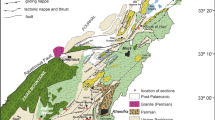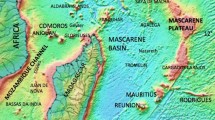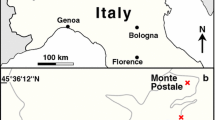Summary
First true coral reefs in Australia appear in the Silurian of northern Queensland. The reef belt then advances to the south and reaches its maximum in the Middle Devonian. In the Upper Devonian and Lower Carboniferous reef-building activity is again restricted to the north. Reefs are unknown from the Upper Carboniferous until the middle Tertiary. The southern limit of the reef belt advances along the west coast, possibly since the Miocene and reaches its extreme southerly position (32° S. lat.) in the late Pleistocene, probably the last Interglacial. Since then it has moved northward to 29° N. lat. In the east the Great Barrier Reef reaches southward as far as 24° N. lat. and no more southerly reefs of Pleistocene or Recent age are known. The significance of these facts for the theory of continental drift is difficult to assess. The Pleospongia („Archaeocyathinae“) of the Cambrian are not reef-builders and their distribution could be satisfactorily explained by assuming that they were restricted to the temperate belts in both hemispheres. Conditions in the Middle Devonian with their extraordinary expansion of reef-building organisms require special explanation, but before a shift of the Australian continent relative to the climatic belts is accepted, it is neccessary to study the very irregular course of the limits of the present reef belt. Comparing marine faunas of similar latitudes today one may encounter differences perhaps not less profound than those between Devonian faunas in comparable belts.
Similar content being viewed by others
Schriften
Brown, I. A.: The Stratigraphy and Structure of the Silurian and Devonian of the Yass-Bowning District, New South Wales. Journ. Proc. Roy. Soc. N. S. W.,74, 312–341, 1941.
Bryan, W. H., andJones, O. A.: The Geological History of Queensland. Univ. Queensl. Pap., Dept. Geol.2 (n. s.), Nr. 12, 103 S., 1946.
Craig, E. K.: Structures in the Northwest Basin in Western Australia. World Oil, S. 211, 1950.
David, T. W. E.: The Geology of the Commonwealth of Australia. Ed. by W.R.Browne. Bd. 1, 747 S., 1950.
Fairbridge, R. W.: Recent and Pleistocene Coral Reefs of Australia. Journ. Geol.58, 330–401, 1950.
Hill, D.: The Lower Carboniferous Corals of Australia. Proc. Roy. Soc. Queensland45, 63–115, Taf. 7–11, 1934.
—: The Devonian Rugose Corals of Lilydale and Loyola, Victoria. Proc. Roy. Soc. Victoria51 (n. s.), 219–256, Taf. 13–16, 1939.
Howchin, W.: Notes on the Discovery of a large Mass of Living Coral in Gulf St. Vincent, with Bibliographic References to the Recent Corals of South Australia. Trans. Roy. Soc. South Aust.23, 242–252, Taf. 16, 1909.
Ladd, H. S.: Reefs and other Bioherms. Rep. Comm. Mar. Ecol. as related to Pal. (1943–44). Nat. Res. Counc. Washington 26–29, 1944.
Laseron, C. F.: The Zoo-geographical Problem of Port Jackson. Austr. Zoologist11, 115–128, 1947.
Lowenstam, H. A.: Niagaran Reefs of the Great Lakes Area. Journ. Geol.58, 430–487, 1950.
Matheson, R. S., andTeichert, C.: Geological Reconnaissance in the Eastern Portion of the Kimberley Division, Western Australia. Dept. Mines West. Austr., Rept. f. 1945, 19 S., 1948.
Ripper, E. A.: Notes on the Middle Palaeozoic Stromatoporoid Faunas of Victoria. Proc. Roy. Soc. Victoria45 (n. s.), 221–243, 1938.
Schwarzbach, M.: Fossile Korallenriffe und Wegeners Drifthypothese. Naturwissenschaften36, 229–233, 1949.
Teichert, C.: The Devonian of Western Australia. Amer. Journ. Sci.241, 69–94, 167–184, 1943.
—: Contributions to the Geology of Houtman's Abrolhos, Western Australia. Proc. Linn. Soc. N. S.W.71, 145–196, 1947.
—: Middle Devonian Goniatites from the Buchan District, Victoria. Journ. Paleont.22, 60–71, Taf. 16, 1948.
- Observations on Stratigraphy and Palaeontology of Devonian, Western Portion of Kimberley Division, Western Australia. Bur. Min. Res., Geol., Geoph., Australia. Rept. 2, 54 S., 6 Taf., 1949.
—: Discovery of Devonian and Carboniferous Rocks in the North-West Basin, Western Australia. Austr. Journ. Sci.12 (1949), 62–65, 1950 a.
—: Late Quaternary Changes of Sea-Level at Rottnewt Island, Western Australia. Proc. Roy. Soc. Victoria59 (n. s.), 63–79, Taf. 5, 6, 1950 b.
Author information
Authors and Affiliations
Rights and permissions
About this article
Cite this article
Teichert, C. Fossile Riffe als Klimazeugen in Australien. Geol Rundsch 40, 33–38 (1952). https://doi.org/10.1007/BF01803206
Issue Date:
DOI: https://doi.org/10.1007/BF01803206




